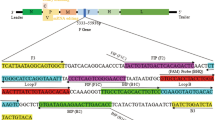Abstract
There are no effective antiviral treatments for pigeon circovirus (PiCV); thus, rapid diagnosis is critical for effective control of the disease caused by this virus. The recent development of a novel LAMP technique that amplifies nucleic acids rapidly with high specificity and sensitivity under isothermal conditions has overcome some of the deficiencies of nucleic-acid-based diagnostic tests. We established a LAMP method for rapid detection of PiCV using two pairs of primers that were designed from PiCV and compared its sensitivity and specificity with that of PCR. Amplification by LAMP was optimal at 63 °C for 60 min. The detection limit was nearly 0.5 pg of PiCV DNA, making it ten times more sensitive than PCR. There was no cross-reaction with porcine circovirus type 2 (PCV2), pigeon Trichomonas gallinae, or pigeon herpesvirus (PHV) under the same conditions. The assay also successfully detected the pathogen DNA in the tissues of infected pigeons. This is the first report indicating that LAMP is a valuable, rapid method of detecting PiCV with high sensitivity and specificity.




Similar content being viewed by others
Abbreviations
- BIP:
-
Backward inner primer
- FIP:
-
Forward inner primer
- LAMP:
-
Loop-mediated isothermal amplification
- PCR:
-
Polymerase chain reaction
- PiCV:
-
Pigeon circovirus
- PCV2:
-
Porcine circovirus type 2
- PHV:
-
Pigeon herpesvirus
References
Abadie J, Nguyen F, Groizeleau C, Amenna N, Fernandez B, Guereaud C, Guigand L, Robart P, Lefebvre B, Wyers M (2001) Pigeon circovirus infection: pathological observations and suggested pathogenesis. Avian Pathol 30:149–158
Coletti M, Franciosini MP, Asdrubali G, Passamonti F (2000) Atrophy of the primary lymphoid organs of meat pigeons in Italy associated with circovirus like particles in the bursa of Fabricius. Avian Dis 44:454–459
Csagola A, Lorincz M, Tombacz K, Wladar Z, Kovacs E, Tuboly T (2012) Genetic diversity of pigeon circovirus in Hungary. Virus Genes 44:75–79
Duchatel JP, Todd D, Smyth JA, Bustin JC, Vindevogel H (2006) Observations on detection, excretion and transmission of pigeon circovirus in adult, young and embryonic pigeons. Avian Pathol 35:30–34
Duchatel JP, Todd D, Willeman C, Losson B (2009) Quantification of pigeon circovirus in serum, blood, semen and different tissues of naturally infected pigeons using a real-time polymerase chain reaction. Avian Pathol 38:143–148
Franciosini MP, Fringuelli E, Tarhuni O, Guelfi G, Todd D, Casagrande Proietti P, Falocci N, Asdrubali G (2005) Development of a polymerase chain reaction-based in vivo method in the diagnosis of subclinical pigeon circovirus infection. Avian Dis 49:340–343
Fu S, Qu G, Guo S, Ma L, Zhang N, Zhang S, Gao S, Shen Z (2011) Applications of loop-mediated isothermal DNA amplification. Appl Biochem Biotechnol 163:845–850
Gough RE, Drury SE (1996) Circovirus-like particles in the bursae of young racing pigeons. Vet Rec 138:167
Hattermann K, Soike D, Grund C, Mankertz A (2002) A method to diagnose Pigeon circovirus infection in vivo. J Virol Methods 104:55–58
Mankertz A, Hattermann K, Ehlers B, Soike D (2000) Cloning and sequencing of columbid circovirus (coCV), a new circovirus from pigeons. Arch Virol 145:2469–2479
Marlier D, Vindevogel H (2006) Viral infections in pigeons. Vet J 172:40–51
Notomi T, Okayama H, Masubuchi H, Yonekawa T, Watanabe K, Amino N, Hase T (2000) Loop-mediated isothermal amplification of DNA. Nucleic Acids Res 28:E63
Raue R, Schmidt V, Freick M, Reinhardt B, Johne R, Kamphausen L, Kaleta EF, Muller H, Krautwald-Junghanns ME (2005) A disease complex associated with pigeon circovirus infection, young pigeon disease syndrome. Avian Pathol 34:418–425
Schmidt V, Schlomer J, Luken C, Johne R, Biere B, Muller H, Krautwald-Junghanns ME (2008) Experimental infection of domestic pigeons with pigeon circovirus. Avian Dis 52:380–386
Smyth JA, Carroll BP (1995) Circovirus infection in European racing pigeons. Vet Rec 136:173–174
Smyth JA, Weston J, Moffett DA, Todd D (2001) Detection of circovirus infection in pigeons by in situ hybridization using cloned DNA probes. J Vet Diagn Invest 13:475–482
Soike D (1997) Circovirus infections in pigeons. Tierarztl Prax 25:52–54
Soike D, Hattermann K, Albrecht K, Segales J, Domingo M, Schmitt C, Mankertz A (2001) A diagnostic study on columbid circovirus infection. Avian Pathol 30:605–611
Song C, Wan H, Yu S, Han X, Qiu X, Hu Q, Tan L, Ding C (2012) Rapid detection of duck hepatitis virus type-1 by reverse transcription loop-mediated isothermal amplification. J Virol Methods 182:76–81
Todd D, Weston JH, Soike D, Smyth JA (2001) Genome sequence determinations and analyses of novel circoviruses from goose and pigeon. Virology 286:354–362
Todd D, Duchatel JP, Weston JH, Ball NW, Borghmans BJ, Moffett DA, Smyth JA (2002) Evaluation of polymerase chain reaction and dot blot hybridisation tests in the diagnosis of pigeon circovirus infections. Vet Microbiol 89:1–16
Wang C, Pang VF, Jeng CR, Lee F, Huang YW, Lin YL, Hsiao SH, Lai SS (2011) Detection of porcine circovirus type 1 in commercial porcine vaccines by loop-mediated isothermal amplification. Folia Microbiol (Praha) 56:483–489
Woods LW, Latimer KS, Niagro FD, Riddell C, Crowley AM, Anderson ML, Daft BM, Moore JD, Campagnoli RP, Nordhausen RW (1994) A retrospective study of circovirus infection in pigeons: nine cases (1986-1993). J Vet Diagn Invest 6:156–164
Yu XP, Zhu C, Zheng XT, Mu AX, Yu HT (2009) Cloning and analysis of the complete genomes of pigeon circovirus from Zhejiang Province. Bing Du Xue Bao 25:355–361
Zhou S, Han S, Shi J, Wu J, Yuan X, Cong X, Xu S, Wu X, Li J, Wang J (2011) Loop-mediated isothermal amplification for detection of porcine circovirus type 2. Virol J 8:497
Acknowledgements
These studies were supported by Grants to Kuo Pin Chuang from the National Science Council (NSC) and Council of Agriculture of Taiwan.
Conflict of interest
The authors declare that they have no conflict of interest.
Author information
Authors and Affiliations
Corresponding author
Rights and permissions
About this article
Cite this article
Tsai, S.S., Chang, Y.L., Huang, Y.L. et al. Development of a loop-mediated isothermal amplification method for rapid detection of pigeon circovirus. Arch Virol 159, 921–926 (2014). https://doi.org/10.1007/s00705-013-1906-1
Received:
Accepted:
Published:
Issue Date:
DOI: https://doi.org/10.1007/s00705-013-1906-1




